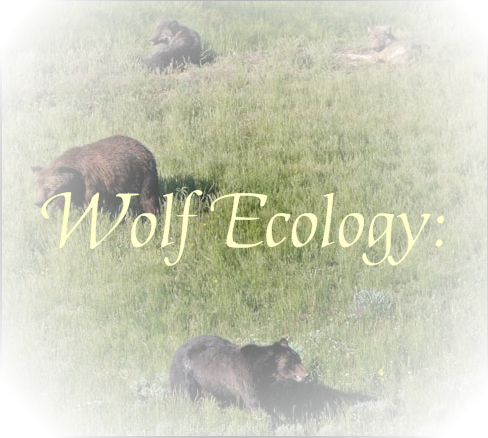
How wolves interact with other predators.
BEARS: Wolves and bears can coexist peacefully and often avoid each other. However, wolf-bear interactions can be quite violent. Grizzly bears (Ursus arctos) will sometimes dig up, kill, and eat wolf pups. As a result, wolf packs will attempt to drive away grizzly bears that get close to the dens where wolf pups are living. Wolves may even attack, and have been known to kill, a grizzly bear that gets too close to the den. Wolves and grizzly bears have been seen fighting over animal carcasses from helicopters in Alaska. Bears will scavenge off of kills made by wolves, and they may try to drive a wolf or a few wolves off of a kill. Wolves can be quite aggressive towards black bears. There are records of wolves preying on black bears (Ursus americanus), and wolves have been known to kill and eat hibernating bears. Wolves will also attack black bear cubs when the mother bear cannot get to them and hurry them up a tree fast enough. Black bears will also occasionally kill wolf cubs.
COUGARS: Wolves will sometimes drive a cougar (Felis concolor) away from a kill it has made so they can eat it themselves. A solitary cougar is often at a disadvantage when it is involved in a fight with a wolf pack, but a cougar may injure and/or kill wolves that try to take over a kill it has made if there are only a few wolves present. It is rare for a wolf to kill a mature cougar, but it has happened and wolves occasionally kill cougar cubs. Overall, wolf-cougar interactions are rarely observed because of the rarity of the two species, but the two generally share an animosity towards each other, since they both prey on large game.
LYNX: Few interactions between lynx and wolves have been documented in North America. Erkki Pulliainen, a researcher at the Univeristy of Helsinki, found that wolves and lynx in Finland seem to be enemies and that they do not share territories. In Hungary and Finland, lynx numbers tend to increase in an area when wolf numbers in that area decrease.
TIGERS AND LEOPARDS: Wolves, tigers (Panthera tigris) and leopards (Panthera pardus) all occur in India. Tigers and leopards often prey on the same animals that wolves do so wolves generally do not share ranges with tigers or leopards. "Billy" Arjan Singh, a well known naturalist who studies tigers, has noted that, before they were driven to near extinction, tigers would sometimes prey on wolves.
WOLVERINES AND OTHER WEASELS: Interactions between wolves and weasels are typically of an aggressive nature. Wolverines (Gulo gulo, which are not as vicious as their reputation suggests they are) are often driven away from a kill they have been feeding on by wolves. Occasionally, the wolverine is killed. Martens, mink and ermines are often killed by wolves, and their carcasses are usually left uneaten. Despite this danger, weasels often scavenge off of abandoned wolf kills.
COYOTES: Wolves will often chase away (and possibly kill ) coyotes (Canis latrans) that venture onto their territory. When wolves were reestablished in Yellowstone National Park, coyote numbers in the park decreased and coyotes disappeared on Isle Royale about eight years after wolves reached the island. Some studies, such as those done by coyote biologist Wendy Arjo, suggest that coyotes often avoid wolves and choose home ranges that lie between the ranges of wolf packs. Coyotes are also active between the hours of 7:00 am and 11:00 am, while wolves are generally active at night. However, some coyotes will scanvenge off of wolf kills and some will even follow a wolf pack from a distance so they can scavenge off of the wolf kills when the wolves are some distance from it. The two species can interbreed, though they rarely do so. However, there is some evidence that the two species have interbred with each other in the eastern United States. Interbreeding between the two species is most likely to occur when wolf numbers are so low that a lone wolf would have a great deal of trouble finding a mate of the same species. Coyotes have also been breeding with the endangered red wolf (Canis rufus).
FOXES: Foxes, like coyotes, weasels, and bears, will scavenge off of wolf kills. Many other species also rely somewhat on food gained from wolf kills. These include eagles, gulls, grey jays, blue jays, stellar's jays, red squirrels, deer mice, black-capped chickadees, boreal chickadees, and bobcats. Wolves will sometimes raid food caches that a fox has prepared, and wolves will also take over old fox dens. Wolves often ignore foxes, since foxes do not compete with wolves for food as foxes hunt much smaller animals than wolves do. However, wolves will chase away, and possibly catch, injure and kill, a fox that was caught feeding on its kill. Most foxes are fast and alert enough to get away from the wolves first. Although it is rare, wolves have been known to prey on red foxes (Vulpes vulpes). Arctic wolves will also prey on arctic foxes (Alopex lagopus) if food is scarce.
ALLIGATORS: Alligators have been known to kill red wolves.
RAVENS:Ravens are often seen flying around the territory of a wolf. Though wolves do not try and eat ravens, (because they have feathers) but sometimes a wolf stop and play with a raven. Ravens also sometimes feed on the dead prey that was hunted by a wolf. But in some ways it seems that the raven and the wolf help eachother out. The raven will help circule around dead prey, and this tells the wolves that there is food near by, and the ravens feed off kill's that are left behind by wolves.

 Free Forum Hosting
Free Forum Hosting